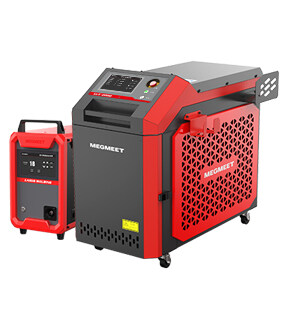Laser welding is a process that uses a highly concentrated beam of light to melt and join materials, such as metals or plastics. It is a modern and advanced technology that has many advantages over conventional welding methods, such as high speed, high quality, high precision, and low distortion. But how did laser welding come to be? What are the milestones and breakthroughs that shaped its development? In this article, Megmeet-welding will trace the history of laser welding from its inception to its current state, and explore the future trends and challenges of this fascinating technology.

I. The Birth of Laser Welding: 1960s
The history of laser welding begins with the invention of the first laser in 1960 by Theodore Maiman at Hughes Research Laboratories. He used a ruby crystal as the lasing medium and a flashlamp as the energy source to produce a red laser beam. This sparked a wave of interest and research in the field of laser physics and applications.
One of the earliest applications of laser was welding. Scientists soon discovered that a laser beam could heat and melt metal, creating a strong and deep weld. The first laser welding experiments were conducted in 1962 by researchers at the American Optical Company, who used a neodymium-doped glass laser to weld steel and titanium. In 1964, another milestone was achieved by Geusic and Smith at Bell Labs, who invented the neodymium-doped yttrium aluminum garnet (Nd: YAG) laser, which had higher power and efficiency than the glass laser. The Nd: YAG laser became one of the most widely used lasers for welding, especially for micro-welding and fiber-optic transmission.
II. The Development of Laser Welding: 1970s-1990s
The next decades saw significant improvements in laser welding technology, both in terms of performance and cost. One of the main drivers was the development of carbon dioxide (CO2) lasers, which had higher power output and lower cost than solid-state lasers. CO2 lasers were first used for welding in 1970 by researchers at Western Electric Company, who welded copper wires with a 1 kW CO2 laser. CO2 lasers soon dominated the industrial market for laser welding, especially for high-volume and high-speed applications, such as the automotive and aerospace industries.
Another important advancement was the introduction of fiber lasers in the late 1980s by researchers at Southampton University in the UK. Fiber lasers use optical fibers as the lasing medium, which has several advantages over conventional lasers, such as high beam quality, high efficiency, low maintenance, and easy integration with robots or CNC machines. Fiber lasers also had higher power density and penetration depth than CO2 lasers, making them suitable for thick-section welding.
III. The Innovation of Laser Welding: 2000s-Present
The current era of laser welding is marked by innovation and diversification. New types of lasers have been developed or improved, such as disk lasers, diode lasers, ultrafast lasers, and hybrid lasers. These lasers offer different characteristics and capabilities for different applications and materials. For example, disk lasers have high brightness and stability; diode lasers have low cost and compact size; ultrafast lasers have short pulse duration and minimal heat input; hybrid lasers combine laser with arc or plasma welding to enhance flexibility and quality.
Laser welding has also expanded its scope and range to new fields and challenges. Some examples are:
Laser welding of dissimilar materials, such as steel and aluminum, which have different physical and chemical properties that can cause intermetallic formation or cracking.
Laser welding of transparent materials, such as glass or plastic, requires special techniques to couple the laser beam into the material.
Laser welding under special conditions, such as in a vacuum or underwater, poses difficulties for conventional welding methods.
Laser welding for additive manufacturing uses laser to deposit layers of material to create complex shapes or structures.
IV. The Future of Laser Welding: Trends and Challenges
Laser welding is a dynamic and evolving technology that has great potential for further growth and improvement. Some of the trends and challenges that may shape the future of laser welding are:
Increasing demand for higher power, higher quality, higher efficiency, and lower cost lasers that can meet the needs of various industries and applications.
Developing new materials or coatings that can enhance the performance or durability of laser welds or reduce the negative effects of thermal stress or corrosion.
Improving the automation and digitalization of laser welding processes can enable more flexibility, customization, monitoring, and optimization.
Addressing the environmental and social impacts of laser welding that can affect energy consumption, waste generation, emission reduction, safety regulation, and skill development.
V. Conclusion
Laser welding is a remarkable technology that has come a long way since its inception in the 1960s. It has undergone several stages of development, from the birth of the first laser to the innovation of new types and applications of laser welding. It has also faced various challenges and opportunities, from the improvement of performance and cost to the expansion of scope and range. Laser welding is still a vibrant and promising technology that has much to offer for the future. If you are interested in learning more about laser welding or finding the best laser welding solutions for your needs, contact us today. We are experts in laser welding and can provide you with professional advice and service.
Related articles:
1. Robotic Laser Welding: The Future of High-Speed Manufacturing
2. Laser Welding: Precision Fusion for Modern Manufacturing
3. 2023 Top 5 Rated Laser Welders & Welding Machines for Sale
4. 5-Step Laser Welding Process: How Does It Work?
5. Arc Welding vs. Laser Welding: The Key Differences




